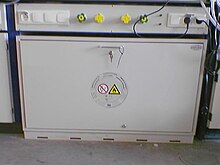Safety cabinet
This article has multiple issues. Please help improve it or discuss these issues on the talk page. (Learn how and when to remove these template messages)
|




A safety
Primarily, they should meet three major safety requirements:
- Minimize the fire rating). It should prevent the materials stored in the cabinet from contributing to the spread of fire or leading to an explosion in the event of a fire
- Minimize the amount of vapor released into the working environment
- Retention of accidental spillages within the cabinet
Areas of application and uses are diverse: pharmaceutical, universities, hospitals, industry, workshops, public organizations working with hazardous substances etc. In essence, any facility where flammable substances are stored.
Legislation and guidance
In the UK, the most relevant regulation and guidance documents regarding the storage of flammable substances are:
- DSEAR 2002:
- HSG51: The storage of chemicalproduction site or end user.
- HSG140: This Health & Safety Guidance (HSG) publication from the HSE is for those responsible for the safe use and handling of flammable liquids in all general work activities, small-scale chemical processing and spraying processes. It explains the fire and explosion hazards associated with flammable liquids and will help you determine how to control the risks in your workplace.
- HSG71: This Health & Safety Guidance (HSG) hazardousmaterials and the relationships of those materials with each other. Particular focus is given to general recommendations for the separation or segregation of different classes of dangerous substances, including flammable liquids. This is essential practice to prevent reaction between incompatible product types possibly having extremely severe consequences for human life and property.
- GHS: Globally harmonised system, is now the universal cross border guidance document that governs appropriate signage for safety boxes
Structure
The
Safety cabinets usually consist of the following components: inner body, fire protection insulation, outer body, fresh air inlets and
Safety cabinets to BS EN14470-2 for
Models are available in various widths, heights and fire resistance classes and with a choice of door and locking systems:
- Widths (in cm): 60, 90, 120, 140
- Heights: Tall units or under-bench units available in various heights
- Fire resistance classes: F15, F30, F60, F90 or G15, G30, G60, G90 Protection against fire (in minutes)
- Door and locking systems: Wing and folding doors available with sensor-controlled and fully automated door opening/closing
Operation
Connection of safety cabinets to a permanent exhaust air system is recommended. If a safety cabinet is not connected to a technical exhaust air system, a certain area in front of and around the cabinet is considered a Zone 2
To prevent damage to the cabinet by corrosion, no acids or alkalis may be accommodated in this type of cabinet: TRbF Appendix L: Storage equipment in working areas (safety cabinets)/ points 4.1 and 4.2 as well as BGR 104 2.2.8).
If the connection to an exhaust air system is not possible on site, solvent and safety cabinets can be technically ventilated with a recirculating air filter unit. These units filter the exhaust air from the cabinet through an activated carbon filter, capturing harmful vapors and returning the cleaned air to the working environment.
Function
In the event of a fire and the attainment of an ambient temperature of 50 °C (+0/−10 °C), the drawers, if fitted, must first retract and the doors must automatically close. These actions are normally activated by
Performance
In line with the fire rating, the safety
Testing is conducted as a freestanding single cabinet in a
Inspection and service
In accordance with BS EN 14470, a competent person must regularly inspect safety cabinets. This inspection should include:
- Condition of the fusible links / fire protection valves
- Condition of the fire protection insulation
- Condition of the fire protection seals (intumescent)
- Condition of the hinges
- Functionality of the door closing
- Functionality of the door interlock
- Condition of the body (corrosion)
- Compliance with Ex-areas
- Measurement of the exhaust air volume flow (for technical ventilation)
It is also a requirement of Section 6 of the Health and Safety at Work Act 1974[6] that equipment for use at work are regularly cleaned or maintained.
References
- ISBN 978-3-503-13053-5
- ^ "The Dangerous Substances and Explosive Atmospheres Regulations 2002 - Fire and explosion". www.hse.gov.uk. Retrieved 2021-06-24.
- ISBN 978-3-609-10017-3
- ISBN 978-3-446-43623-7
- ^ "Ratgeber zu F90 Sicherheitsschränken". MEILLER Umwelttechnik (in German). 10 August 2022. Retrieved 28 January 2023.
- ^ "Section 6 of the Health and Safety at Work Act 1974 (HSW Act)".
